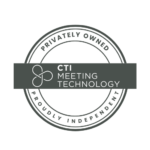Scientific conferences have long been the cornerstone of knowledge sharing. Researchers and industry professionals often use this platform to share their knowledge and discoveries. Traditionally, these conferences resembled university lectures, with an expert covering a specific topic. This format left little room for interaction with other participants. It involved in-person gatherings at physical venues, often limited by geographical and economic constraints.
However, due to the COVID-19 pandemic and the increasing role of technology, events are now evolving with new possibilities for enhanced experiences and accessibility. Event technology helps reach a wider audience by eliminating geographical barriers.
Additionally, interactivity tools – like polling – can transform a seemingly droll lecture into an interactive and insightful experience for both presenters and attendees. Tools like live chats and Q&A allow attendees to interact with the presented content. Event technology offers opportunities to enhance the attendee experience, helping organizers simplify the whole planning process by redirecting their time and effort to other areas that require their utmost attention.
But we are aware that in this rapidly moving environment, it seems like there is a new technology appearing every day. So, how do you choose the right tools for your events? Keep reading to learn about the event technology that every successful meeting uses.
Virtual Platforms for Enhanced Accessibility
Virtual platforms have rocked the meeting technology world. The idea is to replicate the traditional feeling of an in-person conference in a digital space, eliminating the need for physical attendance.
Think about how many more people you can reach! Attendees who would usually travel from abroad can still participate without the need to go to the venue and spend money and time. In addition, researchers from all over can attend without the constraints of travel or visa requirements, fostering diversity and inclusion. Making your conference accessible is one of the biggest challenges as an organizer. But thankfully, event technology offers tools to make your conference more diverse and inclusive, enhancing the whole event experience.
Interactive Features for Engagement
In addition to improving accessibility, virtual conference platforms also include interactive features to engage participants. Gone are the days of long droning lectures. Attendees want to be part of the conversation and offer their input. Besides, one of the goals of scientific conferences is to foster collaboration and share new ideas, so why not use interactive tools to break the ice and encourage participants to engage with the content?
There are (almost) as many options for interactivity tools as fish in the water! The tools you decide to use will depend on many factors, such as event goals, target audience, budget, etc. Virtual poster sessions help presenters showcase their work while attendees can explore the content at their own pace.
Live Q&A sessions are the perfect opportunity to engage with your audience in real time, fostering a dynamic discussion between presenters and participants. Polls can also facilitate conversations while evaluating the audience’s general knowledge about the topic. During breaks, attendees can access networking lounges, a virtual place to meet with other participants and like-minded peers to expand the discussion and share ideas.
Delivering Engaging Presentations
Organizers and attendees are not the only ones who can benefit from these tools. Presenters can also leverage event technology to make their presentations more engaging. By incorporating multimedia elements like videos and images, speakers can create more immersive and captivating talks (since no one wants to sit through a 2-hour-long PowerPoint presentation filled with text-only slides).
In addition, offering presentations as on-demand content once the event has finished will increase the content’s exposure. Like binging content on Netflix, participants can access and revisit sessions at their convenience so they don’t miss any valuable information.
Depending on budget and software provider, organizers can offer augmented reality (AR) and virtual reality (VR) tools. The options are endless, so make sure you do thorough research. Whatever you choose, these tools will impact the event experience and your overall meeting success.
Data Analytics for Insightful Feedback
When you sell clothes, be aware of the latest trends and identify the best sellers in your collection. That way, you make sure that your customers are getting the stuff they need and that you are investing your money wisely. Events are the same. You need to identify the most popular topics and sessions (these are your “clothes”) to guarantee an enjoyable experience for all participants. Event data is your best friend!
By gathering data on attendance, session popularity, and engagement levels, organizers can identify areas of improvement and tailor future conferences to meet the needs and interests of the attendees. The best part? Gathering and analyzing data does not need to be a manual process anymore. By implementing event technology, feedback mechanisms, such as post-conference surveys, can help fully understand the event experience. Automated event analytics are the best way to save time without sacrificing valuable insights.
Collaboration Opportunities
What really sets conferences apart from meetings and lectures is the opportunity to interact with industry experts and meet like-minded peers. Whether your event is onsite, virtual or hybrid, networking and collaboration tools are a great option to add to your conference.
Remember those first days at school or a new job when you go out of your way to introduce yourself to everyone and make small talk? Some people love that! But if you are more of an introvert or don’t know how to start a conversation with strangers, a little help is always welcome. Interactivity and networking tools act as great ice-breakers during your event and push attendees to interact with each other in a relaxed environment.
Virtual chats, networking lounges, or AI-driven matchmaking for networking are some features you can implement to enhance the attendee experience. Even remote attendees can benefit from these tools as if they were at the venue!
Discover the interactivity tools we offer for every conference format here.
Ensuring Security
Organizers need a LOT of attendee data. You usually need personal data such as full name, a valid email address to communicate with them, and any other information regarding their presentations. As virtual conferences become more popular, ensuring data privacy and confidentiality is more important than ever. Organizers must implement robust security measures to protect participant information and prevent online security threats. If this seems too technical, don’t worry! Most event software providers already implement security measures, such as multi-factor authentication, to safeguard participant data.
Furthermore, building trust among participants is essential. Clear communication regarding data protection measures – including options for permanent data deletion – and proactive engagement with security concerns will help establish confidence among attendees. Read more about how to ensure data security during your events here.
Leveraging Hybrid Conferences
Many events are shifting to a hybrid conference model to balance the advantages of both onsite and virtual conferences. This format perfectly blends in-person and virtual components, ensuring a seamless experience for all participants. But while it offers the best of both worlds, it also presents extra challenges for organizers.
The most pressing challenge is ensuring remote and onsite attendees can participate equally during the conference. Thankfully, technology allows you to stream sessions in real-time for remote attendees while offering a chat tool that enables them to interact and ask questions as if they were in the conference room.
While it might require a bit more time and effort to accommodate both in-person and remote attendees, the outcome of having satisfied participants who will recommend your conference is priceless! Case studies of successful hybrid conferences demonstrate the potential of this model in enhancing engagement, accessibility, and overall conference outcomes.
Technical Support for Organizers
Event technology offers great opportunities, but the increasing complexity of conference technology means organizers need adequate support to ensure smooth operations. Ideally, your software provider has a dedicated technical support team to address and resolve any issues during the conference. This will take a weight off your shoulders and ensure end-users receive the support they need right on time. Also, they know the software better than anyone else!
And don’t forget that in order to maximize the benefits of technology, organizers and presenters should receive training on effectively using the available tools to enhance the conference experience. Allocate enough time before the conference to train them in modules they will use and rehearse beforehand.
Sustainable Tools
Promoting sustainable practices is essential now, even at scientific conferences. Transforming traditional events into virtual conferences reduces the carbon footprint associated with travel and accommodation.
We went more in-depth about the impact of conferences on the environment and how organizers can contribute to creating a greener future here. Adapting small changes can make a difference in having a greener future.
Wrapping Up…
We don’t know for sure what technology is going to be available in the near future. We know that event technology advances quickly, and emerging technologies such as artificial intelligence, machine learning, and immersive experiences are shaping the landscape of scientific conferences.
Organizers can make their conferences more dynamic, interactive, and accessible by adapting to these trends and integrations. If you are still not including technology during your event, check out our solutions to discover what suits you best. Embrace the possibilities and leverage event technology to enhance your upcoming conferences in 2024!






